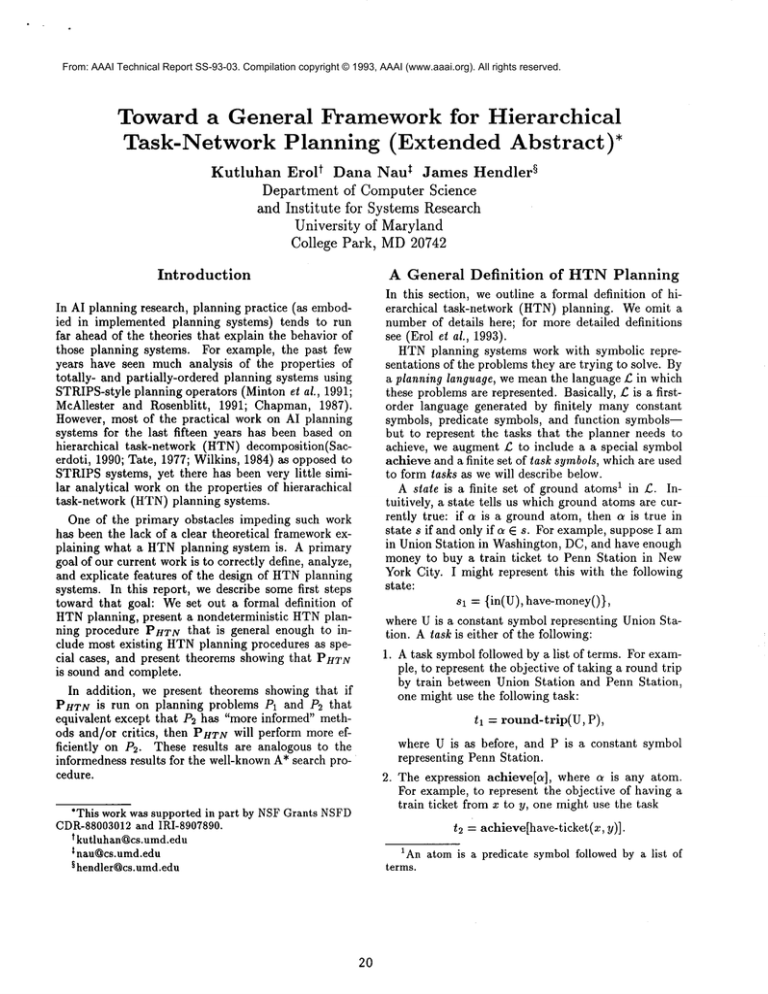
From: AAAI Technical Report SS-93-03. Compilation copyright © 1993, AAAI (www.aaai.org). All rights reserved.
Toward a General Framework for Hierarchical
Task-Network
Planning (Extended
Abstract)*
Erol t Dana Nau $ §James Hendler
Department of Computer Science
and Institute
for Systems Research
University of Maryland
College Park, MD20742
Kutluhan
Introduction
In AI planning research, planning practice (as embodied in implemented planning systems) tends to run
far ahead of the theories that explain the behavior of
those planning systems. For example, the past few
years have seen muchanalysis of the properties of
totally- and partially-ordered planning systems using
STRIPS-styleplanning operators (Mintonet al., 1991;
McAllester and Rosenblitt, 1991; Chapman,1987).
IIowever, most of the practical work on AI planning
systems for the last fifteen years has been based on
hierarchical task-network (IITN) decomposition(Sacerdoti, 1990; Tate, 1977; Wilkins, 1984) as opposedto
STRIPSsystems, yet there has been very little similar analytical workon the properties of hierarachical
task-network (HTN)planning systems.
One of the primary obstacles impeding such work
has been the lack of a clear theoretical frameworkexplaining what a HTNplanning system is. A primary
goal of our current workis to correctly define, analyze,
and explicate features of the design of HTNplanning
systems. In this report, wedescribe somefirst steps
toward that goal: Weset out a formal definition of
HTNplanning, present a nondeterministic tITN planning procedure PHTIVthat is general enough to include most existing HTNplanning procedures as special cases, and present theorems showingthat PHTN
is sound and complete.
In addition, we present theorems showing that if
PHTNis run on planning problems Pi and P2 that
equivalent except that P2 has "more informed" methods and/or critics, then PHTNwill perform more efficiently on P2. These results are analogous to the
informednessresults for the well-knownA*search procedure.
*This workwas supportedin part by NSFGrants NSFD
CDR-88003012
and IRI-8907890.
t kutluhan@cs.umd.edu
nau@cs.umd.edu
§ hendler@cs.umd.edu
2O
A General Definition
of HTN Planning
In this section, weoutline a formal definition of hierarchical task-network (HTN)planning. Weomit
numberof details here; for moredetailed definitions
see (Erol et al., 1993).
HTNplanning systems work with symbolic representations of the problemsthey are trying to solve. By
a planning language, we meanthe language£: in which
these problemsare represented. Basically, £: is a firstorder language generated by finitely manyconstant
symbols, predicate symbols, and function symbols-but to represent the tasks that the planner needs to
achieve, we augment£: to include a a special symbol
achieve and a finite set of task symbols,whichare used
to form tasks as wewill describe below.
A state is a finite set of groundatomsi in £:. Intuitively, a state tells us whichgroundatomsare currently true: if a is a groundatom, then a is true in
state s if and only if a E s. For example,supposeI am
in Union Station in Washington,DC, and have enough
moneyto buy a train ticket to Penn Station in New
York City. I might represent this with the following
state:
si = {in(U), have-money()},
whereU is a constant symbolrepresenting UnionStation. Atask is either of the following:
1. A task symbolfollowedby a list of terms. For exampie, to represent the objective of taking a roundtrip
by train between Union Station and Penn Station,
one might use the followingtask:
tl = round-trip(U, P),
where U is as before, and P is a constant symbol
representing PennStation.
2. The expression achieve[a], where a is any atom.
For example,to represent the objective of having a
train ticket fromz to y, one mightuse the task
t~ = achieve[have-ticket(z, y)].
1Anatomis a predicate symbolfollowedby a list of
terms.
As another example, the objective of having a ticket
from Union Station to Penn Station would be represented by the task
t201 -- achleve[have-ticket(x, y)],
where 01 is the substitution
01 = {U/x,P/y}.
A planning operator o is either of the following:
1. h pair (Name(o), Effects(o)),
. Name(o), the name of o, is a syntactic expression of the form o(xl,...,xn),
where xl,...,xn
are variable symbols;
¯ Effects(o), the effects of o, is a set {cl,...,ck},
where each ci is a set of literals 2 that contains no
variables other than xl,..., xn.
2. A substitution instance o0 of another planning operator o. If o0 contains no variables, t.hen we call it
a ground operator.
Note that we do not include preconditions in our planning operators; these will be handled in the methods
defined below.
Supposes is a state and o is a ground operator. Then
the result of applying o to s is the state
o(s) = (s- {all negative literals in Effects(o)})
U {all positive literals in Effects(o)}.
Intuitively, o(s) is the state resulting from s if we perform the action represented by o.
For example, to represent the action of purchasing
a train ticket from location 11 to location 12, we might
use the following planning operator:
Name: BUY-TICKET(/1,12)
Effects: ’ {-~have-money
0, have-ticket(ll, 12)}
Clearly, the atom have-money0 is too simple-minded
to represent fully the cash-flow effects of paying for
the ticket. To correctly handle resource usage requires
some extensions to the framework. Weintend to deal
with these extensions in our future work.
A plan is a totally ordered set of ground operators.
Intuitively, a task network is a graph structure representing a partially or fully developed plan. More
formally, we will define it to be a pair N = (G, C),
awhere
1. G = (T,-<) is a partially ordered set of tasks and
operators, where T is the set and -< is the partial
ordering. Usually we will represent G by drawing
a directed graph, and for this reason we call G the
graph of N.
2A literal is either an atom (in which case we say the
literal is positive), or the negation of an atom (in which
case wesay the literal is negative.
3Someimplementations of hierarchichical task networks
also associate effects with N. Wehave left themout in the
current formalism, because we believe we can handle them
using constraints. Wewill investigate this issue morefully
in our future work.
21
2. C is a set of constraints called the constraint set of
N. These constraints might involve variable bindings, or they might be protected intervals, i.e., expressions of the form (El, n2,e), where El, n2 E
and e is a statement in £, meaning that in any execution of any plan that is a solution for N, e should
he true in all states between nl and n2. A special
case of this constraint is when nl = n2. It means e
should be true at the state immediately before nl.
(To understand where these states come from, see
the definition of the solution set sol(N) below.)
Note that if P is a plan, then (P, O) is a task network.
As examples, each of the following is a task network
whose constraint set is empty:
NI=
I round-trip(U,P)
N2=
[ achieve[have-ticket(V,P )]]
[ ride-train(U,P)
[ [ achieve[have-ticket(P,U)]
\
] ride-train(P,U)
N3
[achieve[at(ticket-counter)l]
N4
[ achievetat( ticket-counter )]
[ ide-t aln(U,P)
[ achieve[have-ticket(P,U)]
\
[ride-train(P,U)
A method is an ordered pair m = (t, N), where t is
task and N is a task network. Informally, this means
that N is a possible way to achieve t. For example, to
indicate that N2 and Na are ways to achieve the tasks
tl and t2 discussed earlier, we can define the following
methods:
ml
m2
= (tl,N2);
= (t2,N3).
Suppose N is a task network, t is a task in N, m =
(t’, N’) is a method,and 0 is a substitution that unifies
t andt ~. Then we say that m matchest, and we define reduce(N, t, m, 6) to be the task network obtained
from N0 by replacing t9 with the graph of Ng, and
incorporating Ng’s constraint set into N’s constraint
set. This task network is called a reduction of N. Here
are some examples of reductions:
reduce(Nl,tl,ml,O)
reduce(N2,t2Ol,m2,01)]
¯ 0 is any substitution that assigns ground terms to
all variables in T;
¯ the sequence of states (so,sl,...,sn)
satisfies C,
where si = og(si-1) for i-- 1,...,n.
Then we say that the plan P = T’9 is a completion
of N. We use ¢ompl(N, D) to denote the set of all
completions of N.
Let D = (0, M, g, so) be a planning domain, and
N = (G, C) be a task network, where G = (T,-,:)
the partially ordered set of tasks and operators, and C
is the set of constraints. Consider the following recurrence:
if N is primitive;
compl(N, D)
= N2;
= N4;
where 01 = {U/x, P/y} as defined earlier.
A critic function is a function ~ that maps task networks to sets of task networks. Informally, ~ represents
the actions of a critic, which finds problems in a task
network and suggests a way to fix these problems. For
example, suppose that we knowthat it is better to purchase both train tickets at the same time. Then +¢(N4)
might include the following task network, Ns:
S(D, N)
BUY-TICKET(U,P)
N’)
otherwise.
What we would like to do is to define S(D, N) to
the set of all solutions to the planning problem (D, N).
However,the problem with this is that S is ill-defined:
depending on what t¢ and M are, there may be a number of functions S that satisfy Eq. (1). Let ,~ be the
set of all functions S that satisfy Eq. (1). Then
define the set of all solutions for the planning problem
(D, N) to be the following set:
I achieve[at(ticket-counter)]
/
U S(D,
N’ e red(D,N)
\
I [ BUY-TICKET(P,U)
\
ride-train(U,P)
[ ride-train(P,U)
sol(D,
N) = N S(D, g).
(1)
SE8
Every critic function t¢0 needs to satisfy two conditions: For any two task networks N1 and N2 such that
N1 E g(N2), any plan for N1 should also be a plan for
N2, and whenever there is a plan for a task network N,
to(N) should contain a task network for which there
a plan.
An HTN planning
domain is a 4-tuple
D =
(O,M,g, s0), where O is a set of operators, Mis
set of methods, s is a critic function, so is a state in
£ called the initial state, and N is a task network N
representing some problem to be solved. The language
of D is the planning language L: generated by the constant symbols, predicate symbols, and task symbols in
D.
A planning problem is a pair (D, N), where D is
planning domain and N is a task network representing
the problem to be solved. This generalizes the usual
idea of an HTNplanning problem, in which the problem to be solved would typically be represented by a
single task.
Let D = (O, M, to, so) be a planning domain, and
N = (G, C) be a task network, where G = (T,-<)
the partially ordered set of tasks and operators, and
C is the set of constraints. Then red(D, N) is the set
of all reductions of N. If every memberof T is an
operator, then we say that N is primitive (note that
in this case, red(D, N) = 0. Now, suppose that N
primitive, and that
¯ T~ = (ol,..., on) is any total ordering of the operators of T that is consistent with -<;
It may not be immedigtely clear to the reader why
this definition is correct. At the time that we submitted the original version of this paper for review,
it was not completely clear to us either, and thus we
were careful to st£te that this was strictly a preliminary
definition. However, we have subsequently developed
a semantics for HTNplanning, which has allowed us
to prove that sol(D, N) contains precisely those plans
which we would want to consider to be solutions to
(D, N). A discussion of that result is beyond the scope
of this paper; readers are referred to (Erol et al., 1993).
Two planning problems (D,N) and (D’,N’)
equivalent if they have the same solutions, i.e., if
sol(D, N) = sol(D’, N’).
An HTNplanner is a procedure P which takes as
input an HTNplanning problem (D,N), and either
exits with failure or returns a plan P. P is sound if
whenever P(D, N) returns an answer, that answer
in sol(D, g). P is complete if whenever P(D, N) exits
with failure, sol(D, N) =
An Abstract Procedure for HTN
Planning
Below, we present an abstract procedure for hierarchical nonlinear planning. This procedure, which is an
instance of the function P defined earlier, is intended
to be general enough to encompass most existing hierarchical nonlinear planning systems. As stated in
22
Conclusions
the theorems following the procedure, this procedure
is sound and complete, and it has informedness properties analogous to those of the well-known A* search
procedure (for further details and additional results,
see (Erol et al., 1993)).
In this report, we have outlined a formal definition
of HTNplanning. Based on this definition,
we have
presented a nondeterministic HTNplanning procedure
PHTNthat is general enough to include most existing
HTNplanning procedures as special cases. We have
presented theorems showing that PHTNis sound and
complete.
In addition, we have presented theorems showing
that if PHTN is run on planning problems P1 and P2
that equivalent except that /92 has "more informed"
methods and/or critics,
then PHTN will perform more
efficiently on P2. These results are analogous to the
informedness results for the well-known A* search procedure.
While preliminary, these results give a hint of what
can be done by developing a complete formalization
of HTNplanning. In (Erol et al., 1993), we develop
our formalization further, by presenting a semantics
for HTNplanning, and use this to present additional
results. Wehope to use this formalism to investigate
topics such as the following:
¯ completeness, soundness, and complexity of various
specific planning procedures;
¯ complexity and decidability of various classes of
planning problems;
¯ relative
expressivity
of the HTNformalism vs.
STRIPS-style formalisms;
¯ relative efficiency of various commitmentstrategies.
procedureP HTN ( ~., A, M, t~, so, No)
1. Set N := No.
2. If N is primitive, then find a variable assignment and
total ordering that satisfies the constraints in CN,
and halt with success. If such a variable assignment
and ordering cannot be found, then exit with failure.
3. Choose a non-primitive task node t in N. (This is
not a backtracking point.)
choose a method m -4. Nondeterministically
~,
~)
(t N E Mthat matches t and a substitution/9 that
unifies t with t ~, and set N := reduce(N, t, m, 0).
5. Nondeterministically
set N :--
some member of
6. Go to Step 2.
Theorem 1 (Soundness of PHTN) Let D be any
planning domain and No be any planning problem in
D. IfPHTN(D, No) returns an answer, then that answer is a plan in sol(D, No).
Theorem 2 (Completeness
of PHTN)
Whenever PHTN(D,N) exits with failure,
is empty.
sol(D,
References
Chapman, David 1987. Planning for conjunctive
goals. Artificial Intelligence 32:333-379.
Erol, K.; Hendler, J.; and Nau, D. S. 1993. Semantics
for hierarchical task-network planning. Submitted for
publication.
McAllester, David and Rosenblitt, David 1991. Systematic nonlinear planning. In AAAI-91. 634-639.
Minton, S.; Bresna, J.; and Drummond, M. 1991.
Commitmentstrategies in planning. In Proc. IJCAI91.
Sacerdoti, Earl D. 1990. The nonlinear nature of
plans. In Allen,.James; Hendler, James; and Tare,
Austin, editors 1990, Readings in Planning. Morgan
Kaufman. 206-214. Originally appeared in Proc.
IJCAI- 75.
Tate, Austin 1977. Generating project networks. In
Proc. 5th International Joint Conf. Artificial Intelligence.
Wilkins, David E. 1984. Domain-independent planning: Representation and plan generation. Artificial
Intelligence 22(3).
Theorem 3 (Informedness Theorem for Critics)
Let D1 = (O,M, tq,so) and D2 - (O,M, tc2, so)
identical except for their critic functions. Supposethat
for every task network N,
* ~:I(N) C t¢2(N);
¯ sol(D2, N’) = 0 for every N’ e tc2(N) - tq(N).
Then D1 and D2 are equivalent, and the number of
steps required by PHTN(D1,N) <_ the number of steps
required by P HTN(D2,N).
Theorem 4 (Informedness
Theorem for Methods)
Let D1 = (O, Ml,~,so) and D2 = (O, Mz,~,so)
identical except for their sets of methods. Suppose that
¯ M1 C_ M2;
task t
¯ for every
task
network
N,
in N, and method m in M2 - M1 that matches t,
sol(D2, reduce(N, t, re(n)))
Then D1 and D2 are equivalent,
and the number of
steps required by PHTN(D1,N) <_ the number of steps
required by P HTN(D2,N).
23



